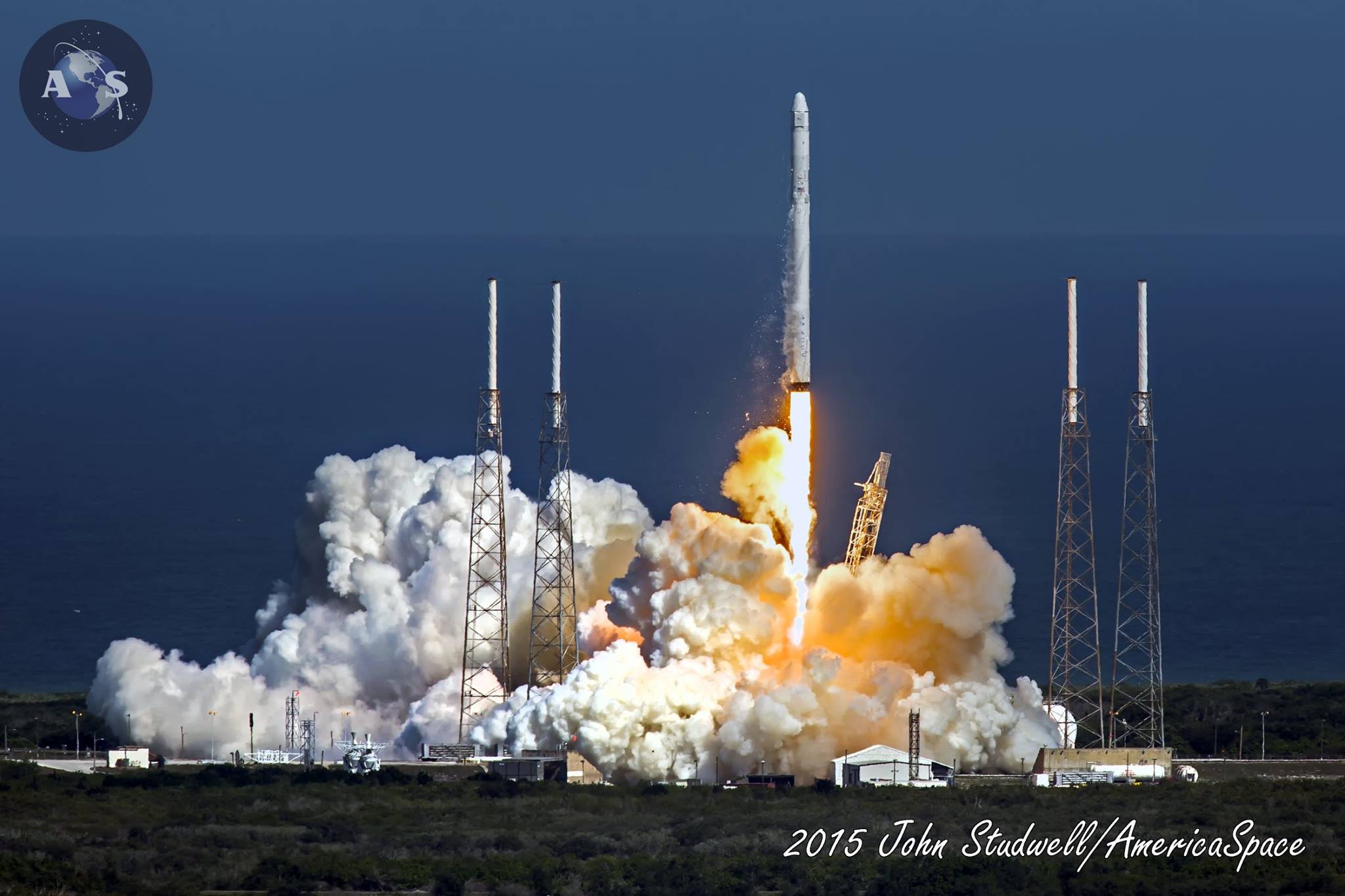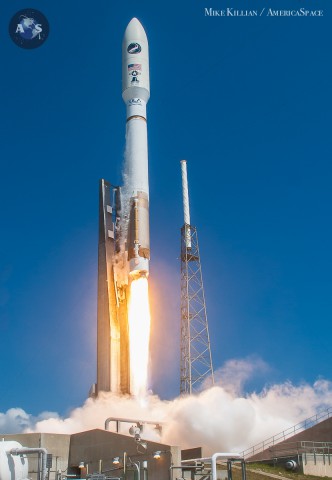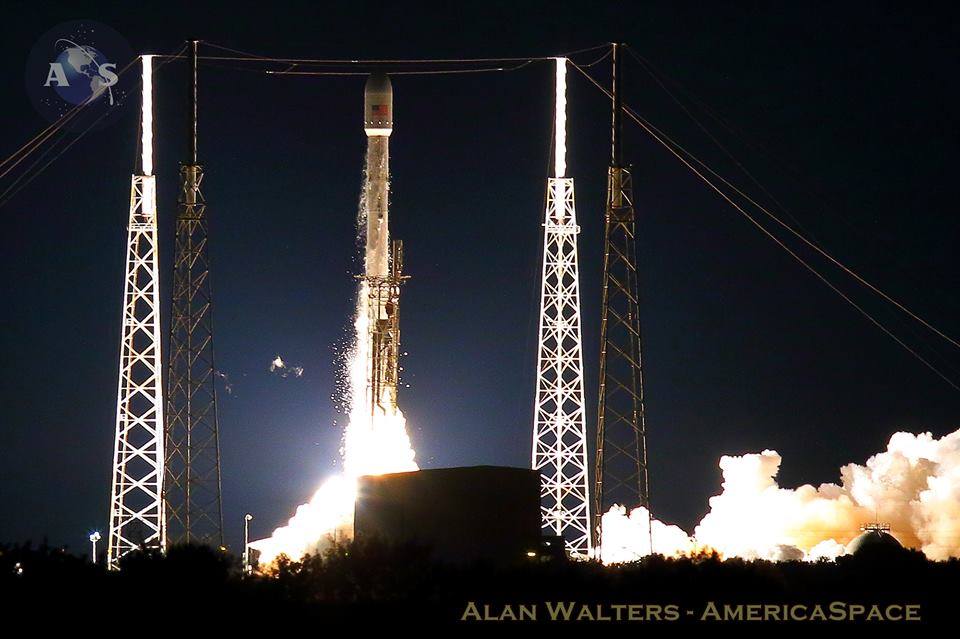
Today it was announced by Lt. Gen Samuel Greaves, Commander of the Air Force Space and Missile Systems Center (SMC) and Air Force Program Executive Officer for Space, that Space Exploration Technologies (SpaceX), the privately-held aerospace company that forced United Launch Alliance (ULA) to develop a new rocket to stay competitive, is now certified to use its Falcon-9 rocket to launch sensitive national security space missions, such as U.S. military satellites or the X-37B which launched just days ago.
SpaceX is now one of two vendors certified to fly these kinds of missions; the other vendor, ULA, has been the sole provider to fly military missions since its creation in 2006. Gen. Greaves remarked: “The SpaceX and SMC teams have worked hard to achieve certification … We’re also maintaining our spaceflight worthiness process supporting the National Security Space missions. Our intent is to promote the viability of multiple EELV-class [Evolved Expendable Launch Vehicle-class] launch providers as soon as feasible.”

Secretary of the Air Force Deborah Lee James stated: “This is a very important milestone for the Air Force and the Department of Defense [DoD]. SpaceX’s emergence as a viable commercial launch provider provides the opportunity to compete launch services for the first time in almost a decade. Ultimately, leveraging of the commercial space market drives down cost to the American taxpayer and improves our military’s resiliency.” SpaceX’s CEO Elon Musk added: “This is an important step toward bringing competition to National Security Space launch. We thank the Air Force for its confidence in us, and look forward to serving it well.”
A U.S. Air Force news article stated the process undertaken to make Department of Defense launches competitive again: “This milestone is the culmination of a significant two-year effort on the part of the Air Force and SpaceX to execute the certification process, and reintroduce competition into the Evolved Expendable Launch Vehicle (EELV) program. The Air Force invested more than $60 million and 150 people in the certification effort which encompassed 125 certification criteria, including more than 2,800 discreet tasks, three certification flight demonstrations, verifying 160 payload interface requirements, 21 major subsystem reviews and 700 audits in order to establish the technical baseline from which the Air Force will make future flight worthiness determinations for launch.”
This effort reached a fever pitch last year as SpaceX’s Musk filed a lawsuit in order to be able to compete for military launches. A previous AmericaSpace article written by Mike Killian in April 2014 stated: “ … On Friday, April 25, Musk announced that his Hawthorne, Calif.-based aerospace company is filing suit in the Court of Federal Claims against the U.S. Air Force’s recent ‘bulk buy’ purchase with ULA. The purchase totals nearly $3 billion for 14 out of 36 required rocket cores from ULA on a sole-source basis, while an additional 14 missions would be awarded competitively (seven of those missions are no longer up for grabs). Musk, however, has not been shy in publicly protesting the fact that SpaceX cannot yet compete against ULA for those contracts, and now it appears he has officially declared war on ULA’s monopoly.”
In addition, at that time Musk discussed ULA’s use of Russian-built RD-180 engines, used by its Atlas V launch vehicle, and benefits of keeping launch technologies stateside: “Our Falcon launch vehicles are truly made in America, designed in California and Texas, with key suppliers spread across the country, and we launch from either Vandenburg Air Force Base or Cape Canaveral Air Force Station. This stands in stark contrast to the ULA’s most frequently flown vehicle, the Atlas-V, which uses a Russian main engine and where approximately half the airframe is manufactured overseas. In light of Russia’s de facto annexation of the Ukraine’s Crimea region and the formal severing of military ties, the Atlas V cannot possibly be described as providing ‘assured access to space’ for our nation when supply of the main engine depends on President [Vladimir] Putin’s permission. Given this development, it would seem prudent to reconsider whether the 36 core uncompeted, sole source award to ULA is truly in the best interests of the people of the United States.”
In June 2014, the U.S. government requested to dismiss this lawsuit. Another AmericaSpace article written by Killian discussed the factors leading to the dismissal request, including the fact that, at the time, SpaceX was not yet able to be certified. In January this year, SpaceX stated that it was dismissing its claims and would work collaboratively with the Air Force in an effort to improve the EELV Program’s competitive landscape.
By July 2014, SpaceX had made great strides in the effort to compete for DoD launches, and had already conducted three consecutive, successful flights, as requested for certification. The first of which was flown from Vandenburg AFB in California for the launch of CASSIOPE on Sept. 29, 2013. The second qualifying flight was carried out from Cape Canaveral for the launch of SES-8 on Dec. 3, 2013, and the third required flight was launched to deliver Thaicom-6 to orbit on Jan. 6, 2014.

However, even though it had already been six months since the last qualifying flight, and 10 months since the first, the certification process criteria was such that the Air Force needed time to thoroughly evaluate the vehicle’s design, reliability, process maturity, and safety systems—a process which the Air Force previously stated would take three months per launch. The Space and Missile Systems Center, which oversees procurement of satellites and rockets for the Air Force, also had to evaluate SpaceX’s Falcon-9 v1.1 manufacturing and operations, systems engineering, risk management, and launch facilities before certifying the launcher as having conducted three successful flights.
The Air Force stated that SpaceX will first have an opportunity to compete for military launches in June, as it will release a Request for Proposal (RFP) for GPS Block III launch services. This new generation of GPS satellites, to be used for military and civilian purposes, is currently being developed by Lockheed Martin. Recently, the first Block III GPS satellite was fully integrated at the company’s Denver, Colo., manufacturing facility, and will undergo further testing this summer. This satellite is being prepared for a projected 2017 launch. The Air Force has stated that it intends to purchase up to 32 Block III GPS satellites. Time will tell as to what surprises this competitiveness will bring for both SpaceX and ULA.
This article was authored by Emily Carney and Mike Killian.
Be sure to “Like” AmericaSpace on Facebook and follow us on Twitter: @AmericaSpace




FINALLY! Great article! Thanks!
There will be some who will be irrationally unhappy about this news. Personally, as a SpaceX agnostic but one who appreciates the power of healthy competition to reign in spiraling launch costs, this should prove interesting how this plays out.
For those that are unhappy, it should be noted that there will be at least two years before the first Air Force launch on a SpaceX vehicle. That certification can be withdrawn if there are enough problems during that time to warrant concern.
Also, the pressure on ULA to innovate might be worth more than readily apparent from the outside. There are a lot of talented people there that can make things happen when given the opportunity. Healthy competition does tend to wake people up.
“Also, the pressure on ULA to innovate might be worth more than readily apparent from the outside. There are a lot of talented people there that can make things happen when given the opportunity.”
This reminds me of a tweet from Tory Bruno after one of SpaceX’s barge landing tests. https://twitter.com/torybruno/status/556107191887732738
“I still have people from DCX. Let me know if we can help”, he says. To me, this rather plainly translates to “ULA could’ve pursued reusable rockets years ago, has the intellectual property and the subject matter experts, but didn’t think it was worth pursuing until SpaceX started pursuing it.”
From the exchange on your link, it seems possible that Bruno is supportive of the SpaceX effort for the leverage that it gives him inside his own company to move forward. Of course I could be projecting.
That wouldn’t surprise me at all, and I should be clear in not blaming Bruno for ULA’s lack of innovation. After all, even though he’s a 30 year LockMart veteran, he has barely been running ULA for a year and has already made the most dramatic changes to the company’s direction that it’s ever seen. SpaceX’s efforts are indeed a significant supporting argument for him to anyone within the company who are resistant to change, just as they’re a significant influence on Arianespace as it tries to figure out how to stay competitive.
A counter-argument would be that SpaceX’s efforts aren’t that significant to ULA, and that the real driver to its strategic shift has been Putin’s interesting behavior and the resulting Congressional hysteria. But I think if SpaceX’s activities weren’t a key factor for Bruno’s changes, then we wouldn’t be hearing him talk about engine reuse or affordability at all, he’d only be pushing a new home-grown expendable engine to satisfy the NIH crowd. ULA’s sole repeat customer, the US government, doesn’t care that much about the price tag, they want reliability. And ULA gives them that.
The only reason for ULA to concern itself with reuse or affordability would be to try to get back into the commercial market. And the only reason for them to get back into the commercial market is if they feared losing their monopoly on DoD/NRO launches, a likelihood for which the writing was on the wall around the same time that Michael Gass was handed his golden parachute.
From where I sit, Bruno has wasted no time making sure that he leaves a significant mark on the history of US launch services. Whether or not people credit SpaceX for being a factor in that, I think his efforts will prove to be a change for the better.
“To me, this rather plainly translates to “ULA could’ve pursued reusable rockets years ago, has the intellectual property and the subject matter experts, but didn’t think it was worth pursuing until SpaceX started pursuing it”
I didn’t quite take it that way, because it was before Bruno was really addressing ULA’s focus on partial reuse.
I figured it was more of a good-natured way of saying “we’ve been there and done that, long ago,” except that they really hadn’t. DCX never boosted payloads to orbit, it was just an atmospheric test program akin to (albeit flying higher than) SpaceX’ Grasshopper and Dev9r test programs.
At the very least, Bruno’s been a refreshing new public relations face for the ULA.
“I figured it was more of a good-natured way of saying “we’ve been there and done that, long ago,” except that they really hadn’t. DCX never boosted payloads to orbit, it was just an atmospheric test program akin to (albeit flying higher than) SpaceX’ Grasshopper and Dev9r test programs.”
Agree on it being a good-natured way of poking the opposition.
Disagree on the DC-X did no more than the Grasshopper and Dev9r (other than fly higher). The DC-X was intended to do (and did) a number of things:
– Test a number of critical flight maneuvers.
– Shut engines down in flight.
– Orient vehicle nose down.
– Right the vehicle.
– Restart engines in flight.
– Not as exciting (but even more important).
– Prove out rapid refueling and turn around procedures.
The DC-X successfully did all those things Grasshopper and Dev9r did not (no attack on them they apparently were not intended to).
More of interest to me is the joint work now being done by ULA and Blur Origin. A number of Delta Clipper Program troops work for Blue Origin. Dr. Bill Gaubatz, the head of the Delta Clipper Program, worked until his untimely death last year as a consultant for Blue Origin.
That is where I would look for any future reusability attempts by ULA.
“– Orient vehicle nose down.
– Right the vehicle.
– Restart engines in flight. ”
And it’s a shame, too. Even if it’s a maneuver that an operational F9 would almost certainly never have reason to do, the hexacopter video of a 42 meter rocket nose diving and then flipping itself over before landing would’ve been fairly impressive..
Yeah, that wasn’t the point (those maneuvers would have been required by the Delta Clipper) and the assertion that the DC-X did no more than the SpaceX test vehicles was inaccurate.
Still if you were a producer for an “extreme” reality TV Show, having an F9 first stage do so would make for good television and nobody has ever accused Musk of not liking publicity
Perhaps they should try to just land the thing before trying it though.
Yes, I expect more careful wording would have avoided looking like I was dismissing the DC-X achievements. The DC-X team achieved aerobatic maneuvers never even attempted by SpaceX’ Grasshopper and Dev9r.
The point I was after though was that SpaceX had already moved past what the DC-X program was doing – research flights of atmospheric test vehicles. That’s the role SpaceX achieved with Grasshopper and Dev9 – despite that DC-X demonstrated more agile flight capability in that role.
Post Dev9r, SpaceX moved on to to testing powered landing techniques on vehicles actually capable of serving as boosters on an orbital launch. That’s a major step past what DC-X achieved. It’s the analog to test flying the actual full-scale Delta Clipper, which never got built.
As for DC-X people going after full reusability with ULA and Blue Origin – from what’s come out of ULA in the last few months, I expect we’ll only see that coming out of Blue Origin, not ULA. ULA’s new tack has been that full reusability still doesn’t make economic sense, but recovery and re-use of just the engines might.
“As for DC-X people going after full reusability with ULA and Blue Origin – from what’s come out of ULA in the last few months, I expect we’ll only see that coming out of Blue Origin, not ULA. ULA’s new tack has been that full reusability still doesn’t make economic sense, but recovery and re-use of just the engines might.”
That is probably true. I say probably because nobody (outside Blue Origin) knows exactly what their intentions/goals are.
Based on the former Delta Clipper personnel involved, it makes sense to speculate their long range goal is a reusable Two Stage To Orbit (TSTO) vehicle.
I agree it is unlikely ULA will make such an attempt, but it is rather remarkable they are even publically discussing partial reusability.
The point I was attempting to make is that if Blue Origin is attempting to produce a TSTO using the BE3 for the second stage and the BE4 for the first stage, the arrangement with ULA gets the rest of the BE4 development funded by ULA (with perhaps purchases of BE3 for the second stage of the ULA vehicle)and that frees up Blue Origin money for work on other hardware.
Well now LM can get the VentureStar off the shelve and gives us SSTO reusable spacecraft at a fraction of what they have been gouging the tax payer..
Since the market is so small and there seems to be a penalty for using the best technology available it appears a powerful hi-tech monopoly is going to be replaced by an inferior one with lesser capability. If I was a general I would do everything I could to keep any military payloads from ever flying on the rocket whose maker sued the Air Force and degraded United Space space capabilities.
Sorry, typo, that would be:
“the rocket whose maker sued the Air Force and degraded United States space capabilities.
If you were a general, I’d defect.
You would not- I would have you put up against a wall and shot before you could.
I guess a lot of people should be glad you have no chance of becoming a general.
Yes, thank you so much for that Joe. Well done.